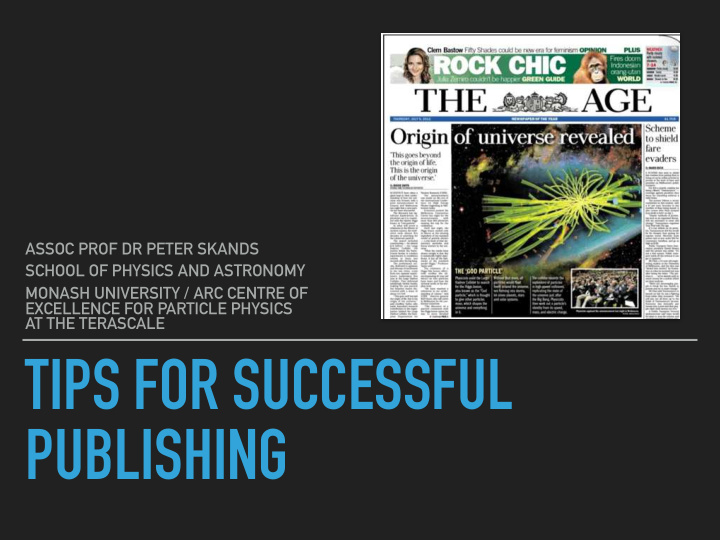



ASSOC PROF DR PETER SKANDS SCHOOL OF PHYSICS AND ASTRONOMY MONASH UNIVERSITY / ARC CENTRE OF EXCELLENCE FOR PARTICLE PHYSICS AT THE TERASCALE TIPS FOR SUCCESSFUL PUBLISHING
PETER SKANDS - SCHOOL OF PHYSICS AND ASTRONOMY WHY AM I HERE? 1 Pythia 6.4 MC Papers commonly cited by ATLAS and CMS as of 2012-02-18, from ’papers’, excluding self-citations fraction of ATLAS & CMS papers that cite them GEANT4 0.8 Anti-k t jet alg. 0.6 Plot by GP Salam based on data from ATLAS, CMS and INSPIREHEP CTEQ6 PDFs MSTW2008 PDFs CTEQ6.6 PDFs MC@NLO heavy-flavour Herwig 6 MC 0.4 RPP2010 POWHEG (2007) ALPGEN LO* PDFs MC@NLO MadGraph4 FEWZ NNLO Herwig++ MC JIMMY CT10 PDFs Z1 UE Tune Pythia 8.1 FastJet 0.2 0 HIGHEST-CITED PUBLICATION ON ARXIV IN 2011-2012 (WRITTEN WITH 2 CO-AUTHORS) (NOW SURPASSED BY HIGGS BOSON DISCOVERY & PLANCK SATELLITE RESULTS)
PETER SKANDS - SCHOOL OF PHYSICS AND ASTRONOMY #1 COLLABORATE AND LEARN Seek every opportunity to go to the best places in the field; work with the best; learn from the best ▸ Publish with the best; they will mentor you on what they consider a good paper, how to write it, publish it ▸ The strength of their reputation will help cross thresholds while yours is developing ➤ kick off a strong publication record Your peers will notice whom you publish with, and future employers & funding agencies will appreciate whom you have worked with / whom you get reference letters from ▸ Everyone appreciates good writing skills! (Practice makes perfect!) No unique recipe ➤ room to develop your own style.
PETER SKANDS - SCHOOL OF PHYSICS AND ASTRONOMY #2 A GOOD PAPER IS CREATIVE, USEFUL, AND RIGOROUS New & worth sharing ➤ worth reading ➤ worth citing ▸ Solid and honest scientific analysis, including discussion of uncertainties. ▸ All claims fully backed up by proof/references (especially controversial ones!) ▸ Make it easy for people to understand what you have done, and to use it ▸ Establish clear narrative and key new idea(s) in abstract/intro ▸ Consider how your work is likely to be used. What can you provide to help people apply or test your ideas/methods/solutions? Supplementary code, documentation, instructions, pieces of good/helpful advice? Note: tempting to ‘sit’ on an idea and keep working at it until it can solve all the world’s problems. My advice: divide and conquer! ‣ Publish in stages (provided each piece still above ‘quality journal’ threshold)
PETER SKANDS - SCHOOL OF PHYSICS AND ASTRONOMY PEER REVIEW Peer review isn’t perfect (but the best we have) ▸ Referees (even editors!) can be bigots, snobs ▸ Your work won’t always be evaluated on strictly objective scientific grounds ▸ Anticipate bias and prejudice. Construct your arguments accordingly ▸ Don’t take it personally. Plenty of high-quality journals out there
PETER SKANDS - SCHOOL OF PHYSICS AND ASTRONOMY I LOOK AT WHETHER JOURNALS OFFER OPEN ACCESS #3 ETHICAL CONSIDERATIONS I LOOK AT WHETHER THEY ARE NOT-FOR-PROFIT , AND IF NOT HOW BIG THEIR PROFIT MARGINS ARE ▸ If you’re at a university like Monash, with a well- funded library, you may not realise the incredible cost and profits of some academic journals ▸ Think public health care; even though you don’t see the bill, you (taxpayers) still pay. ▸ Recall that we write the papers and we do the peer review! (Often we even do much of the typesetting) Example : Elsevier is the largest publisher of scholarly journals in the world. According to The Economist, Elsevier made $1.1 billion in profit in 2010 with a profit margin of 36%, which grew to a reported profit margin of 39% in 2013, and 37% in 2014. In 2012, more than 15,000 academics signed a petition stating that they would snub the Elsevier journals that failed to “radically change how they operate”. The protest failed to gain enough support to trouble Elsevier: last year the company received article submissions from 1.8m authors.
PETER SKANDS - SCHOOL OF PHYSICS AND ASTRONOMY NOTE ON IMPACT FACTORS (IF), AND RELATED METRICS I encourage you to be leaders, not followers . If you revolutionise the field, it is not you who should be thanking the journal, but the other way around. ▸ The quality of your research should be unassailable, no matter where you publish ➤ Publishable in any ‘good’ journal in your field You should nonetheless be aware of the need of administrators (including potential future employers, promotion committees, grant agencies) to focus on a few very simple metrics to evaluate academic performance + impact, and some consequences this may have for you ▸ IF of journals you have published in may be used as a proxy for your research quality/impact ▸ The IFs of journals mostly measures short-term impact (# citations in the first 1 to 5 years) ▸ The focus on short term ➤ market for ‘sensationalist’ (or ‘ambulance chasing’) papers, with short shelf lives. (May be a good fit for you if you are a fountain of ideas.) E.g., letter journals renowned for high short-term IFs (ignoring much worse long-term ones). ▸ Thorough lasting research takes longer (lower output rate) and may be published in - well, not crap journals - but just standard high-quality ‘good’ ones ➤ Competitive if long shelf life
Recommend
More recommend